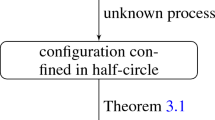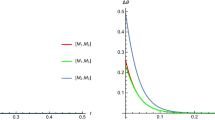Abstract
The Kuramoto model is a canonical model for understanding phase-locking phenomenon. It is well-understood that, in the usual mean-field scaling, full phase-locking is unlikely and that it is partially phase-locked states that are important in applications. Despite this, while there has been much attention given to existence and stability of fully phase-locked states in the finite N Kuramoto model, the partially phase-locked states have received much less attention. In this paper we present two related results. Firstly, we derive an analytical criteria that, for sufficiently strong coupling, guarantees the existence of a partially phase-locked state by proving the existence of an attracting ball around a fixed point of a subset of the oscillators. We also derive a larger invariant ball such that any point in it will asymptotically converge to the attracting ball. Secondly, we consider the large N behavior of the finite N Kuramoto system with randomly distributed frequencies. In the case where the frequencies are independent and identically distributed we use a result of De Smet and Aeyels on partial entrainment to derive a condition giving (with high probability) the existence of a partially entrained cluster. We also derive upper and lower bounds on the size of the largest entrained cluster, together with a lower bound on the order parameter. Interestingly in a series of numerical experiments we find that the observed size of the largest entrained cluster is predicted extremely well by the upper bound.













Similar content being viewed by others
References
Acebrón, J.A., Perales, A., Spigler, R.: Bifurcations and global stability of synchronized stationary states in the Kuramoto model for oscillator populations. Phys. Rev. E 64, 016218 (2001)
Acebrón, J.A., Bonilla, L.L., Pérez, C.J., Vicente, F.R., Spigler, R.: The Kuramoto model: a simple paradigm for synchronization phenomena. Rev. Modern Phys. 77(1), 137–185 (2005)
Aeyels, D., Rogge, J.A.: Existence of partial entrainment and stability of phase locking behavior of coupled oscillators. Progress Theor. Phys. 112(6), 921–942 (2004)
Pikovsky, M.R.A., Kurths, J.: Synchronization: A Universal Concept in Nonlinear Sciences, vol. 12. Cambridge University Press, New York (2003)
Bronski, J.C., DeVille, L., Park, M.J.: Fully synchronous solutions and the synchronization phase transition for the finite-N Kuramoto model. Chaos 22(3), 033133 (2012)
Bronski, J.C., Gambill, T.N.: Uncertainty estimates and \({L}_2\) bounds for the Kuramoto–Sivashinsky equation. Nonlinearity 19(9), 2023 (2006)
Canale, E., Monzo, P: Almost global synchronization of symmetric Kuramoto coupled oscillators. In: Systems Structure and Control. InTech (2008)
Chiba, H.: A proof of the Kuramoto conjecture for a bifurcation structure of the infinite-dimensional Kuramoto model. Ergodic Theory Dyn. Syst. 35(3), 762–834 (2013)
Chiba, H., Medvedev, G.S., Mizuhara, M.S.: Bifurcations in the Kuramoto model on graphs. Chaos 28(7), 073109 (2018)
Chopra, N., Spong, M.W.: On exponential synchronization of Kuramoto oscillators. IEEE Trans. Automat. Control 54(2), 353–357 (2009)
Collet, P., Eckmann, J.-P., Epstein, H., Stubbe, J.: A global attracting set for the Kuramoto–Sivashinsky equation. Commun. Math. Phys. 152, 203–214 (1993)
Dietert, H.: Stability and bifurcation for the Kuramoto model. J. Math. Pures Appl. 105(4), 451–489 (2016)
Dietert, H., Fernandez, B., Gérard-Varet, D.: Landau damping to partially locked states in the Kuramoto model. Commun. Pure Appl. Math. 71(5), 953–993 (2018)
Dörfler, F., Bullo, F.: On the critical coupling for Kuramoto oscillators. SIAM J. Appl. Dyn. Syst. 10(3), 1070–1099 (2011)
Ermentrout, G.B. Synchronization in a pool of mutually coupled oscillators with random frequencies. J. Math. Biol., 22(1), (1985)
Fernandez, B., Gérard-Varet, D., Giacomin, G.: Landau damping in the Kuramoto model. Ann. Henri Poincaré 17(7), 1793–1823 (2015)
Giacomelli, L., Otto, F.: New bounds for the Kuramoto–Sivashinsky equation. Commun. Pure Appl. Math. 58(3), 297–318 (2005)
Goldman, M., Josien, M., Otto, F.: New bounds for the inhomogenous Burgers and the Kuramoto–Sivashinsky equations. Commun. Partial Differ. Equ. 40(12), 2237–2265 (2015)
Gray, C.M.: Synchronous oscillations in neuronal systems: mechanisms and functions. J. Comput. Neurosci. 1(1–2), 11–38 (1994)
Ha, S.-Y., Ha, T., Kim, J.-H.: On the complete synchronization of the Kuramoto phase model. Physica D 239(17), 1692–1700 (2010)
Jitomirskaya, S., Simon, B.: Operators with singular continuous spectrum: III. Almost periodic schrödinger operators. Commun. Math. Phys. 165(1), 201–205 (1994)
Khalil, H.K.: Nonlinear Systems. Prentice Hall, Upper Saddle River (2002)
Kuramoto, Y.: Chemical Oscillations, Waves, and Turbulence. Springer, Berlin (1984)
Kuramoto, Y.: Collective synchronization of pulse-coupled oscillators and excitable units. Physica D 50(1), 15–30 (1991)
Nicolaenko, B., Scheurer, B., Temam, R.: Some global dynamical properties of the Kuramoto–Sivashinsky equations: nonlinear stability and attractors. Physica D 16(2), 155–183 (1985)
De Smet, D., Aeyels, D.: Partial entrainment in the finite Kuramoto- Sakaguchi model. Physica D 234(2), 81–89 (2007)
Strogatz, S.H.: From Kuramoto to Crawford: exploring the onset of synchronization in populations of coupled oscillators. Physica D 143(1–4), 1–20 (2000)
Strogatz, S.H., Mirollo, R.E.: Stability of incoherence in a population of coupled oscillators. J. Stat. Phys. 63(3–4), 613–635 (1991)
Strogatz, S.H., Mirollo, R.E., Matthews, P.C.: Coupled nonlinear oscillators below the synchronization threshold: relaxation by generalized Landau damping. Phys. Rev. Lett. 68(18), 2730–2733 (1992)
Torre, V.: A theory of synchronization of heart pace-maker cells. J. Theor. Biol. 61(1), 55–71 (1976)
Verwoerd, M., Mason, O.: Global phase-locking in finite populations of phase-coupled oscillators. SIAM J. Appl. Dyn. Syst. 7(1), 134–160 (2008)
Verwoerd, M., Mason, O.: On computing the critical coupling coefficient for the Kuramoto model on a complete bipartite graph. SIAM J. Appl. Dyn. Syst. 8(1), 417–453 (2009)
Wittenberg, R.W.: Dissipativity, analyticity and viscous shocks in the (de)stabilized Kuramoto–Sivashinsky equation. Phys. Lett. A 300(4), 407–416 (2002)
Wittenberg, R.W.: Optimal parameter-dependent bounds for Kuramoto–Sivashinsky-type equations. Discret. Contin. Dyn. Syst. A 34(12), 5325–5357 (2014)
Author information
Authors and Affiliations
Corresponding author
Additional information
Communicated by Shin-ichi Sasa.
Publisher's Note
Springer Nature remains neutral with regard to jurisdictional claims in published maps and institutional affiliations.
Rights and permissions
About this article
Cite this article
Bronski, J.C., Wang, L. Partially Phase-Locked Solutions to the Kuramoto Model. J Stat Phys 183, 46 (2021). https://doi.org/10.1007/s10955-021-02783-5
Received:
Accepted:
Published:
DOI: https://doi.org/10.1007/s10955-021-02783-5




